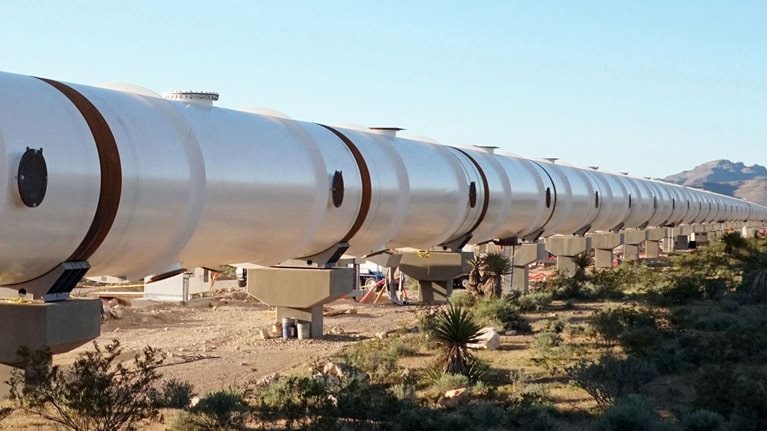The hyperloop is a proposed mode of on-demand, all-electric, and autonomous transportation that moves people and goods at speeds up to 670 miles per hour through a low-pressure tube. Commercializing the hyperloop could be the next great leap in high-speed transport, which hasn’t seen the emergence of a major new mode in more than 100 years. If the technology’s potential is fully realized, hyperloop will transform the lives of billions of people by reducing travel times, disrupting supply chain models, and changing where we live and work.
A physical version of the Internet.
Virgin Hyperloop One—the only company that has built a full-size and full-system hyperloop—has run successful tests since the spring of 2017 on their 500-meter DevLoop test site in Nevada. On December 15, 2017, Virgin Hyperloop One completed the third phase of testing, achieving speeds of 387 kilometers per hour. On February 19, 2018, they announced a preliminary agreement to build the world’s first hyperloop in India, connecting the cities of Pune and Mumbai.
On February 28 and March 1, 2018, GII hosted an Innovation Site Visit for infrastructure leaders to experience Virgin Hyperloop One’s technology first hand—from origin at the Los Angeles Innovation Campus, to realization at the Las Vegas DevLoop test site. In presentations and roundtable discussions with senior Virgin Hyperloop One executives and engineers, participants explored their design, software-inspired engineering ethos, and path to adoption, as well as the potential, constraints, and impacts of this new technology in geographies around the world.
Drawing from Virgin Hyperloop One’s strategy, the following themes were discussed:
- Define the competitive edge. One of hyperloop’s critical value propositions is its speed across distances from 50 to 600 kilometers. Rather than competing with every player in a region’s existing transportation system—such as airlines, intra-city rail and ridesharing services—a hyperloop would integrate with them as part of an end-to-end interoperable system. Focusing on delivering this specific competitive advantage in a cost-effective manner enables the company to streamline resources and stay focused on their product.
- Determine the optimal business case for the specific location. The hyperloop offers a variety of business models, ranging from passenger to freight transport, or a combination of the two. Additionally, a hyperloop could negate the building of additional infrastructure by alleviating congestion in a region. For example, connecting Heathrow and Gatwick airports with a hyperloop could create a linked, scale solution to a number of London’s air connectivity challenges. Carefully defining the optimal business case with government and key stakeholders as an essential first step.
- Simplify constantly. A fully operational hyperloop would be a novel and radical departure from how we travel today. However, innovators can avoid reinventing the wheel by breaking down the technology into simpler individual components and looking for solutions where they already exist. For example, there are lessons from adjacent industries like aerospace and rail to develop engineering and safety solutions. In a similar vein, using materials that are widely available in every market can maximize efficiency and reduce cost.
- Apply lessons from software engineering to building the hardware. Agile methodologies, commonly applied in software development, can accelerate progress on hardware as well. Rapid prototyping and iterative testing of core components, can result in faster delivery and rapid innovation.
- Forge the right partnerships. Having made great strides in proving their technological feasibility, a priority for Virgin Hyperloop One is building the right consortiums to finance, build, and operate their systems. In partnering with existing experts, from engineering and construction firms to operators the company plans to increase the speed of delivery and reduce the risks of the final product. Additionally, local partnerships will facilitate processes like the procurement and manufacturing of system components by tapping into the local ecosystem.
- Channel competitive energy to incentivize adoption. There is little doubt that the public sector will need to assume significant risk in adopting disruptive technology of this scale. However, there are also significant first mover’s advantages such as co-developing regulatory frameworks and the economic development benefits from local manufacturing, skills development, and tourism. Harnessing the customer’s desire to be an early adopter could offset some of the risk and create greater impetus for adoption.
- Consider the spillover effects. Hyperloop technology would not only transform the transportation industry; it would also have a wealth of spillover effects on real estate, urban regeneration, and employment. By providing high-speed connections between communities that might previously have been hours apart, the hyperloop would open new parcels of land outside of city centers, making them more feasible for residential and commercial activity. It would also increase the demand for skills to manufacture, service and operate the hyperloop system.
- The inaugural iteration is crucial. The successful deployment of the first fully operational hyperloop will be critical to secure public buy-in and build a solid reputation from the outset, thereby enabling scaling and investment for other hyperloops to follow. Pursuing quality partnerships, collaborative contracting, prefabrication techniques, and automation could significantly influence the delivery of an on-time and on-budget first hyperloop system.


